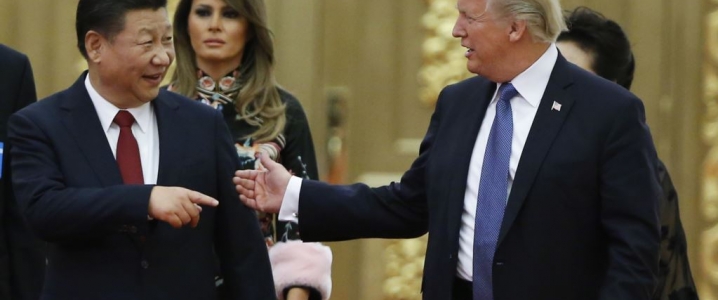
Oil prices are likely to jump if Trump and Xi can hash out a deal.
The U.S. and China have started to sketch out the framework of a comprehensive trade deal, including on some of the thorniest issues that have long prevented an agreement, according to a new report from Reuters.
The progress comes at the eleventh hour of the trade negotiations. In late 2018, President Trump punted on steeper import tariffs on Chinese goods, declaring a ceasefire and setting a March 1 deadline for a trade deal. If both sides couldn’t reach an agreement, Trump vowed to move forward with tariff hikes from 10 to 25 percent on $200 billion worth of Chinese imports.
The odds were stacked against the talks. The U.S. demands didn’t just include buying some more American goods, but sweeping structural changes to the way it says China unfairly props up its own businesses. In the first few weeks of the year, there seemed to be little progress, raising the specter of a huge escalation in the trade war at a time when the global economic expansion is running on fumes.
Now, suddenly, there seems to be major progress. Sources told Reuters that “the broad outline of what could make up a deal is beginning to emerge from the talks,” even though serious disagreement remains. The outline includes memorandums of understanding on six overarching issues, Reuters says, including forced technology transfer and cyber theft, intellectual property rights, services, currency, agriculture and non-tariff barriers to trade.
That is, uh, a rather ambitious list of issues to tackle. It is entirely possible that the two sides cannot reach an agreement at all. In fact, much of the progress so far has been on trade imbalances. For instance, China has offered to buy an additional $30 billion worth of American agricultural products, such as soybeans, corn and wheat. This is easy stuff compared to some of the so-called “structural” issues on the agenda, such as intellectual property rights, barriers to the Chinese market for American companies, state support for Chinese companies and currency controls. Some skeptics wonder if the gulf between the two sides can ever be bridged.
However, having come this far, another possibility is that the talks are extended and the tariff threat is taken off of the table, something that President Trump suggested he would be open to. His flexibility suggests negotiators are making significant progress. The flip side is that China may be unwilling to make deep concessions, but could be offering just enough to drag out the talks and put off new tariffs. Time will tell.
A breakthrough on trade negotiations, or at least the suspension of new tariffs, could conceivably remove one of the most bearish factors threatening oil prices this year. The U.S.-China trade war would inflict damage on both sides, and because China’s economy is already decelerating, new tariffs could be painful. And, as the world’s growth engine, a sputtering Chinese economy would have global implications.
Europe is already feeling the pain. German manufacturing activity fell to its lowest level since 2012 in February. “In terms of the factors behind the slowdown in manufacturing order books, many of the usual suspects — the uncertainty relating to US-China trade tensions and weakness in the autos industry — were highlighted, although there were also reports of growing competitive pressures within Europe” Phil Smith, an economist at IHS Markit, told the FT.
There is also another major land mine lurking just over the horizon – the Trump administration is reviewing possible tariffs on imported autos, something that would almost certainly rattle global manufacturing. The White House just received a report from the Commerce Department that reviewed the national security implications of auto manufacturing, the basis for which could be used by Trump to slap tariffs on car imports. VW’s CEO said that the biggest threat to its profit this year would be U.S. tariffs. Still, this threat remains speculative.
The U.S., too, is arguably not as strong as it outwardly seems. Growth has been inflated because of massive corporate tax cuts phased in last year, the effects of which should wear off. Also, the U.S. is sitting on at least a few sub-prime bubbles – one for autos and one for corporate debt. The Federal Reserve also hiked interest rates multiple times last year, tightening the overall credit environment. In the face of global economic headwinds, the Fed backed off earlier this year on its hawkish plans to hike rates even more.
And the U.S. can only weather a global slowdown for so long. The Trump administration cannot do much about a slowdown elsewhere, but the trade fight is the one arena where it exercises a lot of control. In a few days, we will find out what the president plans to do.
